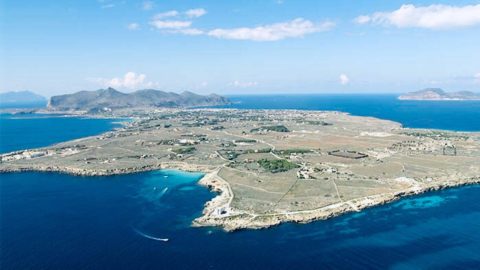Tourists arrive in their thousands and enjoy the beautiful waters and enviable habitat. The Egadi islands, among the most beautiful protected areas in the Mediterranean, continue to be a mine of extraordinary finds. It's been an extraordinary summer, but fame is going around the world for a successful synthesis between ecosystem, environmental protection and archaeological discoveries. There is curiosity, but not amazement because when the activities are coordinated they go well. Therefore, even in the middle of summer, research on the seabed of the archipelago did not stop and two bronze rostrums of ships from the First Punic War have just been recovered.
Equipment of military value, at the end of the prows, which was used to attack enemy ships. War instruments that have marked bloody periods in history for supremacy in the Mediterranean. Rome and Carthage were the main cities to contend for victories. The Hercules ship of the RPM Nautical Foundation has now brought to the surface the two precious objects which have been lying there for over 2 thousand years. In 241 BC. C., a few kilometers from the western coast of Sicily, between the islands of Favignana, Levanzo and Marettimo fought the epic battle between the Roman and Carthaginian fleets. Research in a crystalline and healthy sea has helped the work of the experts.
What a few days ago was not, however, the first discovery in a "war field" investigated by many archaeological missions. The share of finds in state hands has risen to 25 in just a few years. Valeria Li Vigni , Superintendent of the Sea, says that "together with the discoveries of past years, the discoveries of this summer clarify even better the picture of the naval battle of antiquity". The satisfaction of scholars is that the battle of the Egadi Islands - which in fact marked the first Punic war - is currently the best documented. Yet there is still a lot of history to be reconstructed. The Carthaginians lost fifty ships in that battle and the remains of the fleet serve as a historical-tourist attraction for numerous divers.
The Sicilian authorities keep the area under observation to bring back to the museums everything that can be taken from the seabed. Supervision and management of the area they fight diving and fraudulent finds. In the caves under the islands you can still find everything and who knows if some piece hasn't already escaped the controls. Underwater archaeologists are on the increase and in Sicily they are now Diving specialized for group diving. Hopefully everyone goes deep respecting the rules on the protection of artistic heritage and nature. Italy is known to be a victim of the international trade in submerged and surfaced finds, as the annual reports of the Carabinieri and Guardia di Finanza tell us. A colossal tour that knows no boundaries with environmental and ecosystem repercussions.
Institutions can always do more, but – he said Alberto Samona Councilor for Cultural Heritage of Sicily - both at sea and on land sites, archaeological research in Sicily is constant and makes use of prestigious national and international collaborations. For the Region, 2021 is characterizing itself as an extraordinary working season and there is talk of the 'spring of archeology'. A political definition certainly auspicious. But it is clear that alone is not enough to give confidence to other findings that lie at the bottom of the mare nostrum. And not just there.





